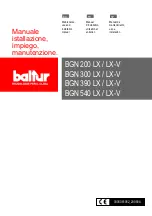
9.13.3
Heat rise adjust
This DIP switch is used to select desired temperature rise
in the heating mode.
Refer to table 15.
Table 15 – Heat rise adjust
S4-1
RISE
OFF
35 °F
ON
30°F
9.13.4
Continuous fan speed
Using the communicating thermostat R02P032, select
the LOW continuous fan speed. In User Menu, go to "Fan
Settings" and choose "LOW".
9.13.5
Furnace test mode
S4-2 and S4-3 - The Test Switches will place the furnace
into a test mode, operating the furnace at continuous
input rates of either 100% of full rate (maximum fire) or
40% of full rate (minimum fire). This is accomplished by
setting the Test Switches. See table 16.
To enter the furnace test mode, proceed as follows:
1. Switch the 120 volt power to the furnace OFF. Do
not change settings with control energized.
2. Position Test Switches for the desired test mode.
3. Switch the 120 volt power to the furnace ON.
4. Set the thermostat mode to HEAT; adjust the set
point at least 4°F above room temperature to
demand a call for heating.
The furnace will operate at the fixed test mode until on e
of the following conditions :
• The thermostat is satisfied and the call for heat is
removed.
• The furnace has been in test mode continuously for
sixty minutes, at which time the furnace control will
exit the test mode and proceed to normal heating
operation as configured.
Test mode cannot be
activated again unless line voltage power to the
furnace is cycled off and back on. This is true even
if the DIP switches remain configured to the test
settings
Table 16 – Test mode
S4-2
S4-3
DESCRIPTION
ON
OFF
40% TEST
OFF
ON
100% TEST
10
USER’S
INFORMATION
MANUAL
Do not store or use gasoline or other flammable vapors
and liquids in the vicinity of this or any other appliance.
Installation and service must be performed by a qualified
installer, service agency, or the gas supplier.
Read all instructions in this manual and retain this and all
additional instructions for future reference.
To keep your operating costs low and to eliminate
unnecessary service calls, we have provided a few
guidelines. These guidelines will help you understand
how your gas furnace operates and how to maintain it so
you can get years of safe and dependable service. Read
all the instructions in this manual, and keep all manuals
for future reference.
For your safety, read the following before operating your
furnace:
1. The furnace area must be kept clear and free
of combustible materials, gasoline, and other
flammable vapors and liquids.
2. Insulating materials may be combustible. A furnace
installed in an attic or other insulated space must be
kept free and clear of insulating materials. Examine
the furnace when it is installed and also any time
insulation is added.
3. For proper safe operation, the furnace needs air
for combustion and ventilation.
Do not block or
obstruct air openings to the area in which the
furnace is installed, and the spacing around the
furnace.
4. This furnace is equipped with an ignition device
which automatically lights the burners.
5. Should the gas supply fail to shut off or if
overheating occurs, shut off the gas valve to the
furnace before shutting off the electrical supply.
6. Do not use the furnace if any part has been under
water.
A flood damaged furnace is extremely
dangerous. Attempts to use the furnace can result
in fire or explosion.
A qualified service agency
should be contacted to inspect the furnace and
to replace all gas controls, control system parts,
electrical parts that have been wet, or the entire
furnace if deemed necessary.
7. Examine the furnace installation to determine that:
• All flue gas carrying areas external to the
furnace, such as the chimney and vent
connector, are clear and free of obstructions.
• Vent connector is in place, slopes upward, and
is physically sound without holes or excessive
corrosion.
• Return air duct connection(s) is physically
sound, sealed to the furnace casing, and
terminates outside the space containing the
furnace.
• Physical support of the furnace is sound
without sagging, cracks, gaps, etc. around the
28
Summary of Contents for CC15-M-V
Page 18: ...Figure 17 Wiring Diagram 18...
Page 23: ...Figure 25 Direct vent clearance 23...
Page 24: ...Figure 26 Other than Direct vent clearance 24...
Page 34: ...12 PART LIST Figure 27 Exploded view...
Page 35: ...Figure 28 Exploded view continued...
Page 36: ...Table 19 Part list Chinook Compact...
Page 37: ...Table 20 Part list continued...
Page 38: ...13 NOTES 38...
Page 39: ...39...
Page 40: ...40...













































